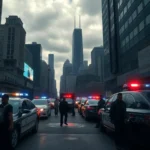Is Chicago dangerous? Shocking truths locals won’t tell you
- Why Everyone’s Asking “Is Chicago Dangerous?”
- Chicago’s Crime Landscape: More Than Just Headlines
- Chicago Crime Statistics: What The Numbers Really Say
- The Most Dangerous Neighborhoods: Where You Really Need To Watch Out
- The Safest Neighborhoods: Where Chicago Shines and You Can Chill
- Common Crimes in Chicago: What You Need To Know To Stay Safe
- How Chicago Police and Community Programs Are Fighting Back
- Real Talk: What Locals Say About Chicago’s Safety (Opinions and Stories)
- Comparing Chicago To Other Dangerous Cities In The US
- Final Thoughts: Is Chicago Dangerous? The Balanced Truth
- Sources and Further Reading
Why Everyone’s Asking “Is Chicago Dangerous?”
Chicago is one of those cities that instantly pops into your mind when you think of iconic American urban life. From deep-dish pizza to the stunning skyline, it’s got a lot going for it. But alongside the fame, there’s a reputation that follows — one about crime and safety that makes folks pause and ask, “Is Chicago dangerous?” This question isn’t just for tourists; locals and potential new residents want to know what risks they might face.
Understanding the real situation matters. It’s not about scaring people off but about knowing where to be cautious and how to stay safe. This article promises to cut through the noise and give you a clear picture of Chicago’s crime landscape. We’ll cover crime stats, break down which neighborhoods are considered risky or safe, share practical safety tips, and even bring in voices from locals who live with this reality every day.
By the end, you’ll have a better sense of the city’s true danger level and how to navigate it smartly — whether you’re just visiting or planning to call Chicago home.
Chicago’s Crime Landscape: More Than Just Headlines
When you hear about Chicago in the news, it’s often about shootings, murders, or other violent crimes. But the danger level in Chicago isn’t just a simple story of “bad everywhere.” Like many big cities in the US, Chicago has a mix of neighborhoods — some that feel sketchy or dodgy, and others that are surprisingly chill and safe.
First off, it helps to understand the difference between violent crimes and property crimes. Violent crimes include things like assaults, shootings, and murders — incidents where people’s safety is directly threatened. Property crimes, on the other hand, involve theft, burglary, or car theft — crimes that target belongings rather than people.
Compared to other risky cities in US, Chicago’s overall crime rate is higher than the national average, but it’s not uniform across the city. Some areas experience much more violence and crime, while others have low incident rates and strong community presence.
The Chicago police play a big role here, working alongside community groups to tackle crime. Efforts like community policing, youth outreach, and tech innovations aim to reduce crime and improve safety. Still, challenges remain, especially in neighborhoods facing poverty and gang activity.
So, while headlines might paint a picture of a city overrun by crime, the reality is more nuanced — it’s a city with rough spots but also many safe places where people live, work, and enjoy life.
Chicago Crime Statistics: What The Numbers Really Say
Let’s break down the latest Chicago crime rates in straightforward terms. According to recent reports, Chicago sees a significant number of violent crimes each year, including murders, shootings, aggravated batteries, and assaults. For example, the murder rate per 100,000 people is notably higher than the national average, but it’s concentrated in specific neighborhoods.
On the property crime side, theft and motor vehicle theft are common. Burglary rates also contribute to the city’s overall crime picture, but these tend to be less violent and more opportunistic.
Here’s a simple table comparing Chicago’s crime stats to national averages and some other unsafe cities in USA:
| Crime Type | Chicago (per 100k) | US Average (per 100k) | Detroit (per 100k) | Baltimore (per 100k) |
|---|---|---|---|---|
| Violent Crime | 1,100 | 400 | 1,800 | 1,600 |
| Murder | 25 | 5 | 43 | 40 |
| Property Crime | 3,200 | 2,200 | 4,000 | 3,800 |
| Motor Vehicle Theft | 800 | 250 | 1,200 | 1,100 |
Looking at the Chicago crime map, you’ll notice hotspots mainly in the south and west sides of the city, while downtown and northern neighborhoods tend to have lower crime rates. This map helps locals and visitors alike understand where to be extra cautious.
The Most Dangerous Neighborhoods: Where You Really Need To Watch Out
Certain neighborhoods in Chicago have earned a reputation as rough spots in US urban life. Areas like Riverdale, Englewood, West Garfield Park, Washington Park, and Austin often come up in discussions about crime and safety.
These neighborhoods face challenges like high poverty rates, gang activity, unemployment, and limited resources — all factors that contribute to higher crime incidents. Locals often warn visitors to avoid these areas, especially after dark, due to isolated incidents of violence or theft.
For example, Englewood has seen a number of shootings and aggravated batteries reported in recent years. Washington Park struggles with gang-related violence that affects community safety. Riverdale, while less talked about, has similar issues tied to economic hardship.
Real stories from residents and news reports highlight the struggles these neighborhoods face. But it’s important to remember that even within these areas, many people live their lives without incident, and community groups work hard to improve conditions.
If you’re new to Chicago or just visiting, it’s wise to be aware of these neighborhoods and avoid them at night or when alone. Stick to well-lit, busy streets and use trusted transportation options.

The Safest Neighborhoods: Where Chicago Shines and You Can Chill
On the flip side, Chicago boasts several neighborhoods known for their safety and community vibe. Places like Edison Park, Forest Glen, Norwood Park, Lincoln Park, and the Gold Coast offer residents and visitors a much lower risk of crime.
These areas benefit from factors like strong community policing, economic stability, active neighborhood associations, and good schools. Locals often praise these neighborhoods for their parks, nightlife, and family-friendly atmosphere.
For newcomers or tourists, spotting a safe area usually means looking for well-maintained streets, visible police presence, and active community events. These neighborhoods often have lower rates of violent and property crimes, making them ideal for exploring or settling down.
Tourists especially enjoy spots like Lincoln Park and the Gold Coast for their mix of safety and attractions. Staying in these areas can help you enjoy Chicago’s amazing offerings without worrying too much about shady situations.
Common Crimes in Chicago: What You Need To Know To Stay Safe
The most frequent crimes in Chicago include car theft, robbery, assault, and unfortunately, shootings in certain areas. Understanding these common incidents helps you take simple steps to protect yourself.
Here are some straightforward safety tips:
- Always lock your car and don’t leave valuables visible inside.
- Stay aware of your surroundings, especially in crowded or unfamiliar places.
- Avoid flashing cash or expensive items that might attract unwanted attention.
- Prefer traveling during daylight hours when possible, as crime rates tend to be lower.
- Use trusted rideshare services or public transportation rather than walking alone late at night.
Locals often share stories about how staying alert and sticking to well-lit streets can make a big difference. Tourists should also heed advice from community forums and official safety resources to avoid dicey situations.
Chicago Crime Rates Compared to Other US Cities (per 100k people)
Violent Crime
Murder Rate
Police Presence
- Chicago: High
- Detroit: Moderate
- Baltimore: Moderate
- St. Louis: Moderate
- New Orleans: Moderate
Community Programs
- Chicago: Active
- Detroit: Limited
- Baltimore: Growing
- St. Louis: Some
- New Orleans: Developing
How Chicago Police and Community Programs Are Fighting Back
The Chicago police department has ramped up efforts to tackle crime through strategies like community policing, which builds trust between officers and residents. They’ve also introduced tech innovations such as surveillance cameras and data-driven patrols to respond faster to incidents.
Youth outreach programs aim to prevent gang involvement by offering alternatives and support. These initiatives have shown some success, though challenges remain in reducing the overall violent crime rates.
Residents can get involved by attending neighborhood meetings, joining watch groups, or staying informed through local resources. Law enforcement’s impact on crime reports and public perception is significant — when police and communities work together, safety improves.
Real Talk: What Locals Say About Chicago’s Safety (Opinions and Stories)
“I’ve lived in Chicago for over 20 years. Sure, some parts are messed up, but most neighborhoods where I hang out are pretty chill. You just gotta know where to go and keep your eyes open.” – Chicago resident, Reddit source
“Tourists often get scared by the news, but downtown and tourist spots like the Loop are usually safe during the day. Just avoid the shady neighborhoods at night.” – Local community forum comment source
“The city’s working hard on community programs and police presence. It’s not perfect, but things are improving in many areas.” – Chicago news discussion source
Comparing Chicago To Other Dangerous Cities In The US
Here’s a quick comparison of Chicago with other trouble areas in America like Detroit, Baltimore, St. Louis, and New Orleans. This table shows how crime rates, violence types, and police efforts stack up:
| City | Violent Crime Rate (per 100k) |
Murder Rate (per 100k) |
Police Presence | Community Programs |
|---|---|---|---|---|
| Chicago | 1,100 | 25 | High | Active |
| Detroit | 1,800 | 43 | Moderate | Limited |
| Baltimore | 1,600 | 40 | Moderate | Growing |
| St. Louis | 1,900 | 60 | Moderate | Some |
| New Orleans | 1,400 | 30 | Moderate | Developing |
Chicago stands out with a strong police presence and active community programs, which helps manage crime despite its size and challenges. Media portrayal often makes these cities seem worse than they are, so understanding the real stats helps you make smarter decisions about travel or moving.
Final Thoughts: Is Chicago Dangerous? The Balanced Truth
To wrap it up, Chicago is a city of contrasts. Its crime statistics show higher rates than the national average, especially in rough spots like Englewood or West Garfield Park. But it also has many neighborhoods where safety is a priority and residents enjoy a good quality of life.
The key is knowing the city’s layout — which areas to be cautious in, and which ones you can explore with confidence. Staying informed, alert, and following simple safety tips will help you enjoy Chicago’s amazing culture, food, and attractions without unnecessary worry.
No city is 100% safe, but with the right knowledge, you can navigate Chicago’s streets smartly and responsibly.
Sources and Further Reading
- Reddit discussion on Chicago safety
- Sparkly Maid blog on Chicago crime
- TripAdvisor forum on Downtown Chicago safety
- Rosenfeld Injury Law on Chicago neighborhoods
- AXA Travel Insurance guide to Chicago safety
- Illinois Policy Institute on Chicago crime trends
- World Population Review: Most dangerous US cities
What do you think about Chicago’s safety? Have you experienced any sketchy or safe moments in the city? How would you like to see Chicago improve its safety? Share your thoughts, questions, or stories in the comments below — your input helps everyone get a clearer picture!
 Crime rate in Chicago 2025: What the shocking numbers really mean
Crime rate in Chicago 2025: What the shocking numbers really mean Safest cities in Illinois you won’t believe made the list
Safest cities in Illinois you won’t believe made the listSi quieres conocer otros artículos parecidos a Is Chicago dangerous? Shocking truths locals won’t tell you puedes visitar la categoría Chicago.

Leave a Reply